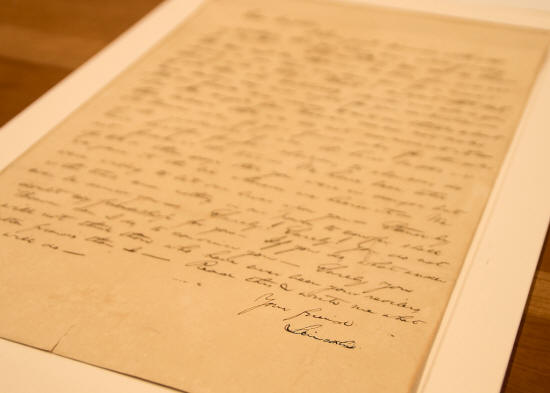|
 “Both these items are wonderful additions to our
collection,” said Alan Lowe, executive director of the Abraham
Lincoln Presidential Library and Museum. “One shows the Lincoln that
we sometimes forget – the politician trying to lead a team. The
other shows Lincoln as we’d like to remember him – hardworking and
never wasting an opportunity to improve himself.” “Both these items are wonderful additions to our
collection,” said Alan Lowe, executive director of the Abraham
Lincoln Presidential Library and Museum. “One shows the Lincoln that
we sometimes forget – the politician trying to lead a team. The
other shows Lincoln as we’d like to remember him – hardworking and
never wasting an opportunity to improve himself.”
The letter was written to Andrew McCormack, one of the “Long Nine,”
a group of nine tall Illinois legislators who banded together and,
among other things, helped make Springfield the state capital.
In the letter, the normally diplomatic Lincoln chastises McCormack
for planning to vote against the group. The issue was whether a
government job would go to a fellow Whig or a rival Democrat.
“All our friends are ready to cut our throats about it,” Lincoln
writes. “For Heaven’s sake, for your friends sake, for the sake of
the recollection of all the hard battles we have heretofore fought
shoulder, to shoulder, do not forsake us this time.”
The letter has been passed down by McCormack’s descendants (who
later used the spelling “McCormick”) for generations. It was owned
most recently by Fred Schneeberger of Atlanta, Ga. His son, Craig,
convinced Mr. Schneeberger that it belonged somewhere that scholars
and the public could benefit from it.

Craig Schneeberger had visited the Lincoln Presidential Library and
was “amazed” by it. “When the time came to donate the letter, we
knew where it needed to go,” he said.
Conservation philanthropist Louis Moore Bacon concluded the Lincoln
Presidential Library and Museum was also the proper home for the
painting “The Young Abe Lincoln.”
The painting by William Morton Jackson Rice dates to the late 1800s.
It is 7 feet wide by nearly 5 feet tall and shows Lincoln, clad in
buckskins, sitting against a tree he has just chopped down. Lincoln
is reading a book while he eats a meal that had been wrapped in a
red bandana.
“The Young Abe Lincoln” will hang in the presidential library for
the rest of the year.
Dr. Samuel Wheeler, the Illinois state historian, thanked
Schneeberger and Bacon for their donations. “We are grateful any
time the owners of precious documents or art decide to share their
possessions with the world. They are ensuring these wonderful items
will be preserved for the good of all,” Wheeler said.
Wheeler also thanked Ian Hunt, the presidential library’s head of
acquisitions, and James Cornelius, curator of the Lincoln
Collection, for their diligence in arranging these donations.
The Lincoln Presidential Library and Museum will celebrate his
birthday Feb. 12 by offering free admission, showcasing some of its
rarest artifacts and presenting musicians and historic interpreters.
The presidential library and museum uses a combination of rigorous
scholarship and high-tech showmanship to immerse visitors in
Lincoln’s life and times. Visitors can see ghosts come to life on
stage, watch TV coverage of the 1860 Presidential election, roam
through the Lincoln White House, experience booming cannons in a
Civil War battle and come face to face with priceless original
Lincoln artifacts.
The library holds an unparalleled collection of Lincoln books,
documents, photographs, artifacts and art, as well as some 12
million items pertaining to all aspects of Illinois history.
For more information, visit
www.President
Lincoln.illinois.gov.

[to top of second column] |


Letter to Andrew McCormack
Andrew McCormack was one of the “Long Nine,” an alliance of Whig legislators
from Sangamon County whose average height was 6 feet. The Long Nine were
instrumental in moving the state capital to Springfield, and McCormack (whose
family later changed the spelling of the name to “McCormick”) would go on to
become mayor of Springfield in 1843.
The letter does not include a date. It most likely was written in January 1839,
when the new General Assembly was convening after the election of the previous
fall. It may have been hand-delivered during the House session to McCormack, who
had been a captain of volunteers in the Black Hawk War.
The issue in dispute was the job of state printer. Abraham Lincoln wanted his
friend and Whig ally Simeon Francis to get the post. He feared that McCormack
was supporting Democrat William Walters, editor of the Illinois State Register
newspaper.
Dear Captain:
I have just learned, with utter astonishment, that you have some notion of
voting for Walters. This certainly can not be true. It can not be, that one so
true, firm, and unwavering as you have ever been, can for a moment think of such
a thing. What! Support that pet of all those who continually slander and abuse
you, and labour, day and night, for your destruction. All our friends are ready
to cut our throats about it. An angel from heaven could not make them believe,
that we do not connive at it. For Heaven’s sake, for your friends sake, for the
sake of the recollection of all the hard battles we have heretofore fought
shoulder, to shoulder, do not forsake us this time. We have been told for two or
three days that you were in danger; but we gave it the lie whenever we heard it.
We were willing to bet our lives upon you. Stand by us this time, and nothing in
our power to confer, shall ever be denied you. Surely! Surely! You do not doubt
my friendship for you. If you do, what under Heaven can I do, to convince you.
Surely you will not think those who have been your revilers, better friends than
I. Read this & write what you will do.
Your friend,
Lincoln

“The Young Abe Lincoln”
This painting is the work of William Morton Jackson Rice (1854-1922). It is oil
on canvas and its size is 56 x 84-¾ inches.

One auction house described the painting this way: “This Romantic view of Abe
Lincoln exemplifies the spirit of the era. Here is the heroic figure: strong,
pure and, as yet, unworried by the hardships of leading a country at war with
itself. Rice has presented him in the pristine Illinois woods, a commentary on
Lincoln's purity of heart and spirit. However, in keeping with the tropes of
other Romantic painters, he wants us to know that while the natural world is
grand and intimidating - it can be controlled. To this end, the handsome and
athletic Lincoln rests after having successfully felled a tree from the great
forest that surrounds him.”
Rice graduated from Cornell University with a degree in architecture, then
turned to painting and studied in New York and Paris. He is most known for his
portraits, which can be found in collections including Rutgers University,
Bowdoin College, Harvard University, West Point Museum and the National Academy
of Design. Rice exhibited work at the Paris Exposition Universelle in 1889, the
Chicago World’s Columbian Exposition in 1893 and other major events.
[Thoele Shanta] |